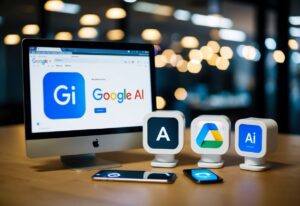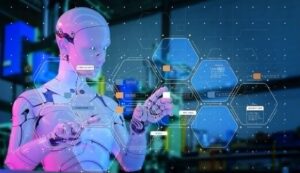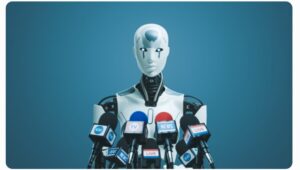Jobs most at risk from AI
Top 10 Jobs most at risk from AI
As artificial intelligence (AI) advances at an incredible pace, its impact on the job market has become a growing concern for many of us. Whether you’re a parent thinking about your child’s future career path or a business leader planning for workforce development, it’s important to understand which jobs are most vulnerable to disruption by AI. In this article, I’ll explore the jobs that face the highest risk of being affected by AI advancements.
Defining AI Risk in the Job Market
Before we dive into the specific jobs, let’s first clarify what I mean by “at risk.” A job is considered at risk when AI can take over a large part of its tasks more efficiently, accurately, or cost-effectively than humans can.
But keep in mind, “at risk” doesn’t always mean a job will disappear. More often, it means that roles might change or that fewer human workers will be needed in that field.
1. Data Entry Clerks
 Data entry clerks are among the first to feel the impact of AI advancements. Traditionally, this job involves manually inputting information from documents, forms, or other sources into databases or spreadsheets.
Data entry clerks are among the first to feel the impact of AI advancements. Traditionally, this job involves manually inputting information from documents, forms, or other sources into databases or spreadsheets.
However, AI technologies like Optical Character Recognition (OCR) and Natural Language Processing (NLP) have drastically improved, enabling machines to scan, read, and input data with high accuracy and speed.
Why at risk?
- AI Efficiency: AI-powered systems can process vast amounts of data quickly and with greater accuracy than humans, reducing the margin for error.
- Automated Processing: OCR software can now recognize and digitize text from scanned images, while NLP allows AI to understand and categorize unstructured data, like handwritten notes or emails.
For instance, AI platforms such as UiPath and Automation Anywhere can automate end-to-end data entry workflows, significantly reducing the need for human intervention in industries like finance, healthcare, and customer service.
Future outlook: While AI will handle most data entry tasks, the role of humans may shift toward managing data quality, verifying information, and overseeing automated systems. This change could reduce the number of pure data entry jobs but open up opportunities in data governance, data validation, and AI system supervision.
2. Manufacturing Workers
The manufacturing industry has long been at the forefront of automation, with robots playing a crucial role on production lines. Over the years, advancements in AI and robotics have further revolutionized manufacturing processes, making human workers less essential in certain areas, especially for repetitive tasks such as assembly, packaging, and quality control.
Why at risk?
- Robotic Efficiency: Robots equipped with AI can work 24/7 without fatigue, performing tasks with precision and consistency.
- Predictive Maintenance and Optimization: AI systems can analyze vast amounts of data from machines to predict potential failures and optimize workflows, further reducing the need for human oversight.
Companies like Siemens and Fanuc have implemented AI-powered robotic arms capable of assembling complex products faster and with greater precision than human workers. AI can also optimize workflows, manage supply chains, and minimize downtime.
Future outlook: Although many low-skill roles may disappear, AI will create demand for workers skilled in operating and maintaining automated systems. Jobs in robotic maintenance, AI systems integration, and manufacturing process optimization will become more valuable. Upskilling in robotics and AI-driven technologies will be essential for workers in this field.
3. Telemarketers
Telemarketing has long been a field with high turnover and relatively low job satisfaction. The advent of AI-driven customer service technologies is poised to further disrupt this industry.
AI-powered chatbots, virtual assistants, and automated dialing systems are increasingly being used to handle customer inquiries, sales calls, and even lead generation. These systems are not only cheaper to maintain but also offer 24/7 availability, making them an attractive alternative for businesses.
Why at risk?
- AI Speech Recognition and NLP: AI systems can now interact with customers through natural-sounding speech, thanks to improvements in speech recognition and NLP. Virtual assistants like Amazon’s Alexa and Google Assistant are capable of engaging in conversations, answering questions, and guiding users through processes.
- Lead Generation and Sales Automation: AI-driven platforms like Conversica and Drift can handle thousands of customer interactions simultaneously, generating leads, following up on inquiries, and even closing sales deals without human intervention.
Future outlook: While routine tasks like cold calling and follow-up calls will be taken over by AI, human telemarketers may shift toward more complex sales roles, such as handling strategic or high-value accounts.
In addition, AI could assist salespeople by providing insights into customer behavior and preferences, allowing for more personalized and effective sales strategies.
Jobs most at risk from AI
4. Retail Cashiers
Retail cashiers are among the jobs most threatened by automation. Self-checkout systems, contactless payments, and mobile apps have already reduced the need for human cashiers in many stores.
AI-driven point-of-sale (POS) systems and fully automated checkout experiences are becoming more popular as retailers look to improve efficiency and reduce labor costs.
Why at risk?
- Self-Checkout Systems: Many retailers have adopted self-checkout stations that allow customers to scan their own items and complete purchases without the assistance of a cashier.
- AI-Powered POS Systems: AI is also playing a role in managing retail operations, from optimizing inventory levels to predicting consumer behavior. Automated payment solutions, such as Amazon Go stores, enable customers to walk in, pick up products, and leave without ever interacting with a cashier, as AI-powered cameras and sensors track purchases and process payments automatically.
Future outlook: While human cashiers may become less common, there will still be a demand for customer service roles focused on assisting customers with more complex issues or providing personalized in-store experiences.
Retail jobs may evolve into more customer-centric and technical roles, such as managing automated systems and enhancing the customer experience.
5. Truck and Delivery Drivers
AI’s impact on the logistics and transportation industry is growing, with self-driving technology posing a significant threat to truck and delivery drivers. Autonomous vehicles have made considerable strides, and while fully autonomous trucks are not yet widespread, companies are already testing them on highways.
Delivery robots and drones are also being developed to handle last-mile deliveries, further reducing the need for human drivers.
Why at risk?
- Self-Driving Vehicles: Companies like Tesla, Waymo, and Uber are developing self-driving trucks and delivery vehicles. These autonomous systems can operate around the clock without fatigue, reducing transportation costs and increasing efficiency for logistics companies.
- AI in Fleet Management: AI-driven systems can optimize delivery routes, monitor vehicle conditions, and predict maintenance needs, streamlining the entire logistics process.
Future outlook: While long-haul driving is at risk of automation, human drivers will likely still be needed in roles that require navigating complex urban environments or overseeing autonomous fleets.
Additionally, jobs related to maintaining and programming autonomous vehicles will become increasingly important. Workers in this field will need to develop skills in AI systems management and vehicle automation technologies.
6. Customer Service Representatives

AI chatbots and virtual assistants are becoming more sophisticated, allowing companies to automate many customer service tasks. These systems can handle FAQs, troubleshoot common issues, and provide 24/7 support, reducing the need for human customer service representatives.
Why at risk?
- AI-powered customer service platforms like Zendesk and LivePerson can engage with customers through chat, email, and phone.
- AI’s ability to resolve issues quickly and consistently reduces the need for large customer service teams.
- Future outlook: Human representatives will focus on handling more complex issues that require empathy and problem-solving, while AI manages routine inquiries.
7. Bank Tellers
The rise of online banking and AI-driven financial services is reducing the need for human bank tellers. Automated teller machines (ATMs), mobile banking apps, and AI-powered chatbots are replacing many traditional banking services.
Why at risk?
- Online banking platforms allow customers to transfer money, pay bills, and manage accounts without visiting a branch.
- AI algorithms can provide financial advice, assess loan applications, and detect fraud.
Future outlook: Tellers may transition to roles that focus on personalized financial advice or complex transactions that require human intervention.
8. Paralegals and Legal Assistants
AI is transforming the legal industry by automating tasks such as legal research, document review, and contract analysis. AI-powered platforms can sift through vast amounts of data in minutes, performing tasks that would take paralegals hours or even days to complete.
Why at risk?
- AI platforms like ROSS Intelligence can analyze case law, statutes, and legal precedents far more efficiently than humans.
- Document automation tools can draft standard contracts and legal agreements.
Future outlook: Paralegals will likely focus on overseeing AI tools, managing complex legal processes, and providing more strategic support to lawyers.
9. Medical Transcriptionists
Medical transcription involves converting physicians’ voice recordings into written reports, a task increasingly being automated through speech recognition technology. AI systems can accurately transcribe medical notes, cutting down on the need for human transcriptionists.
Why at risk?
- AI-driven transcription software can transcribe and format medical records quickly and with fewer errors.
- Technologies like Nuance Dragon Medical One enable real-time transcription during consultations.
Future outlook: Medical transcriptionists may move toward roles in managing and verifying transcribed data or overseeing AI systems in medical records departments.
10. Accountants and Auditors
AI is disrupting the accounting and auditing profession by automating tasks such as data entry, financial analysis, and tax preparation. AI systems can track expenses, generate financial reports, and even identify potential tax savings, reducing the need for traditional accountants.
Why at risk?
- Accounting software like QuickBooks and Xero automates bookkeeping, invoicing, and financial management tasks.
- AI can audit financial records faster and more accurately than humans, identifying discrepancies and potential fraud.
Future outlook: Accountants will likely transition into advisory roles, offering strategic financial planning and analysis, while AI handles the more routine aspects of accounting.
In conclusion, while I recognize that AI is significantly reshaping the job market, it’s important to remember that not all jobs will be replaced. Many roles will adapt, requiring us to develop new skills and shift our focus.
As AI takes over repetitive and task-driven work, I believe there will be more opportunities for us to engage in creativity, critical thinking, and problem-solving—skills that are inherently human.
For parents, this means encouraging our children to pursue careers that promote adaptability and lifelong learning. For business leaders, it’s essential to prepare the workforce for an AI-driven future by investing in upskilling employees and embracing technological changes.
I see this transformation as an opportunity; rather than losing jobs to AI, we can evolve alongside it, finding new avenues for growth and innovation. The future is not just about adapting to AI—it’s about thriving in a world where humans and technology work together.



















